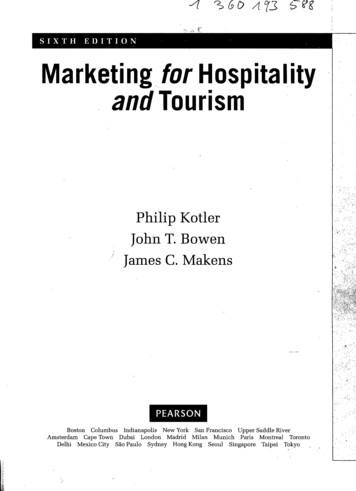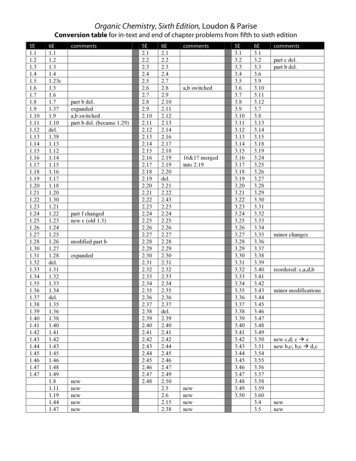
Transcription
ASIXTHE D I T I O NMarketing for Hospitalityand TourismPhilip KotlerJohn T. Bo wenJames C. MakensPEARSONBoston Columbus Indianapolis New York San Francisco Upper Saddle RiverAmsterdam Cape Town Dubai London Madrid Milan Munich Paris Montreal TorontoDelhi Mexico City Sao Paulo Sydney Hong Kong Seoul Singapore Taipei Tokyo
ContentsTo the Student xivPreface xixAbout the Authors xxiPART I Understanding theHospitality and TourismMarketing Process 11Introduction: Marketing forHospitality and Tourism 3YOUR PASSPORT TO SUCCESS 5CUSTOMER ORIENTATION 7WHAT IS HOSPITALITY AND TOURISMMARKETING? 9MARKETING IN THE HOSPITALITYINDUSTRY 10Importance of Marketing 10Tourism Marketing 10MARKETING HIGHLIGHT 11Definition of Marketing 11The Marketing Process 11UNDERSTANDING THE MARKETPLACE ANDCUSTOMER NEEDS 12Customer Needs, Wants, and Demands 12Market Offerings: Tangible Products, Services,and Experiences 13Customer Value and Satisfaction 13Exchanges and Relationships 14Markets 14DESIGNING CUSTOMER-DRIVEN MARKETINGSTRATEGY 15Selecting Customers to Serve 15Marketing Management Orientations 15PREPARING AN INTEGRATED MARKETINGPLAN 19BUILDING PROFITABLE CUSTOMERRELATIONSHIPS 20Customer Relationship Management 21The Changing Nature of CustomerRelationships 22CAPTURING VALUE FROM CUSTOMERS 24Customer Loyalty and Retention 24Growing Share of Customer 25What Is Customer Equity? 25Building the Right Relationships with the RightCustomers 26Building Customer Equity 2 7MARKETING'S FUTURE 27KEY TERMS 27CHAPTER REVIEW 28DISCUSSION QUESTIONS 30EXPERIENTIAL EXERCISES 30INTERNET EXERCISES 30REFERENCES 312Service Characteristics ofHospitality and TourismMarketing 35THE SERVICE CULTURE 36CHARACTERISTICS OF SERVICE MARKETING 37Intangibility 37Physical Evidence 38Inseparability 38Variability 39Perishability 41SERVICE MANAGEMENT CONCEPTS FOR THEHOSPITALITY INDUSTRY 42The Service Profit Chain 42Three Types of Marketing 42MANAGEMENT STRATEGIES FOR SERVICEBUSINESSES 43Managing Service Differentiation 43Managing Service Quality 43MARKETING HIGHLIGHT 44Managing Service Productivity 45Resolving Customer Complaints 45MARKETING HIGHLIGHT: RECOMMENDATIONS FOR IMPROVING SERVICEQUALITY 46Managing Employees as Part of the Product 48Managing Perceived Risk 48Managing Capacity and DemandKEY TERMS 55CHAPTER REVIEW 55DISCUSSION QUESTIONS 56EXPERIENTIAL EXERCISES 56INTERNET EXERCISES 56REFERENCES 5649
Contents3The Role of Marketing in StrategicPlanning 59NATURE OF HIGH-PERFORMANCE BUSINESS 62Stakeholders 62Processes 62Resources. 63Organization 64CORPORATE STRATEGIC PLANNING: DEFININGMARKETING'S ROLE .64Defining the Corporate Mission 65Setting Company Objectives and Goals 67Designing the Business Portfolio 67MARKETING HIGHLIGHT: STARBUCKS COFFEE: WHERE GROWTH IS REALLYPERKING 70MARKETING STRATEGY AND THE MARKETING MIX 72Customer-Driven Marketing Strategy 72Developing an Integrated Marketing Mix 74MANAGING THE MARKETING EFFORT 75Marketing Analysis 75Goal Formulation 78Market Planning 79Implementation 80Feedback and Control 80UNIQUE CHALLENGES OF THE HOTEL INDUSTRY 81KEY TERMS 82CHAPTER REVIEW 83DISCUSSION QUESTIONS 84EXPERIENTIAL EXERCISES 85INTERNET EXERCISES 85REFERENCES 85PART 11 Developing Hospitalityand Tourism MarketingOpportunities andStrategies 874The MarketingEnvironment 89viiEconomic Environment 103Natural Environment 104Technological Environment 105Political Environment 106MARKETING HIGHLIGHT: HOSTILE ENVIRONMENT 107Cultural Environment109LINKED ENVIRONMENTAL FACTORS 110RESPONDING TO THE MARKETINGENVIRONMENT 111Environmental Scanning 112Using Information About the MarketingEnvironment 112KEY TERMS 112CHAPTER REVIEW 113DISCUSSION QUESTIONS 114EXPERIENTIAL EXERCISES 114INTERNET EXERCISES 114REFERENCES 1145Marketing InformationSystems and MarketingResearch 119MARKETING INFORMATION AND CUSTOMERINSIGHTS 121THE MARKETING INFORMATION SYSTEM 122Assessing Information Needs 123Developing Marketing Information 123Marketing Intelligence 129MARKETING RESEARCH 131Defining the Problem and ResearchObjectives 132Developing the Research Plan133MARKETING HIGHLIGHT: ETHNOGRAPHIC RESEARCH: WATCHING WHATCONSUMERS REALLY DO 135MARKETING HIGHLIGHT: PROS AND CONS OF ONLINE RESEARCH 140MARKETING HIGHLIGHT: A "QUESTIONABLE" QUESTIONNAIRE 143Implementing the Research Plan 147Interpreting and Reporting the Findings147THE COMPANY'S MICROENVIRONMENT 91MARKETING HIGHLIGHT: RESEARCH PROBLEM AREAS 148MARKETING HIGHLIGHT: HSMAI'S eCONNECT: A GREAT SOURCE OF MARKETINGINFORMATION 149The Company 91Existing Competitors 91Suppliers 93Marketing Intermediaries 94Customers 95Publics 96THE COMPANY'S MACROENVIRONMENT 96Competitors 96Demographic Environment 98INTERNATIONAL MARKETING RESEARCH 150MARKETING RESEARCH IN SMALLERORGANIZATIONS 151KEY TERMS 151CHAPTER REVIEW 152DISCUSSION QUESTIONS 153EXPERIENTIAL EXERCISES 154INTERNET EXERCISES 154REFERENCES 154
viiiContents6Consumer Markets and ConsumerBuying Behavior 157A MODEL OF CONSUMER BEHAVIOR 158PERSONAL CHARACTERISTICS AFFECTING CONSUMERBEHAVIOR 159Cultural Factors 159Social Factors 162Personal Factors 166MARKETING HIGHLIGHT: THE SAN DIEGO PADRES BASEBALL CLUB 169Psychological Factors 170THE BUYER DECISION PROCESS 174Need Recognition 174Information Search 175Evaluation of Alternatives 176Purchase Decision 177Postpurchase Behavior 177MARKETING HIGHLIGHT: UNIQUE ASPECTS OF HOSPITALITY AND TRAVELCONSUMERS 178KEY T E R M S 1 7 9CHAPTER REVIEW 1 7 9DISCUSSION QUESTIONS 180EXPERIENTIAL EXERCISES 181INTERNET EXERCISE 181REFERENCES 1817Organizational Buyer Behaviorof Group Market 185THE ORGANIZATIONAL BUYING PROCESS 186Market Structure and Demand 186Types of Decisions and the Decision Process 187PARTICIPANTS IN THE ORGANIZATIONAL BUYINGPROCESS 187MAJOR INFLUENCES ON ORGANIZATIONALBUYERS 188Environmental Factors 189Organizational Factors 189Interpersonal Factors 189Individual Factors 189ORGANIZATIONAL BUYING DECISIONS 1891. Problem Recognition 1892. General Need Description 1903. Product Specification 1904. Supplier Search 1905. Proposal Solicitations 1906. Supplier Selection 1907. Order-Routine Specification 1918. Performance Review 191GROUP BUSINESS MARKETS 191Conventions 192Association Meetings 193Corporate Meetings 194Small Groups 195Incentive Travel 195MARKETING HIGHLIGHT: GREEN MEETINGS: THE RIGHT THING TO DO FOR THEENVIRONMENT AND BUSINESS 197SMERFs 198Segmentation of Group Markets by Purposeof the Meeting 198Restaurants as a Meeting Venue 199DEALING WITH MEETING PLANNERS 199THE CORPORATE ACCOUNT AND CORPORATE TRAVELMANAGER 201KEY TERMS 202CHAPTER REVIEW 202DISCUSSION QUESTIONS 203EXPERIENTIAL EXERCISE 203INTERNET EXERCISE 204REFERENCES 2048Market Segmentation, Targeting,and Positioning 207MARKETS 209MARKET SEGMENTATION 209Geographic Segmentation 209Demographic Segmentation 211Gender 212MARKETING HIGHLIGHT: TARGETING FAMILIES BY TARGETING KIDS 213Psychographic Segmentation 214Behavioral Segmentation 215MARKETING HIGHLIGHT: THE VFR TRAVELER SEGMENT 216Requirements for Effective Segmentation 219MARKET TARGETING 219Evaluating Market Segments 219Selecting Market Segments 220Choosing a Market-Coverage Strategy 222MARKET POSITIONING 222Positioning Strategies 223Choosing and Implementing a PositioningStrategy 224Product Differentiation 225Selecting the Right Competitive Advantages -228Communicating and Delivering the ChosenPosition 229Positioning Measurement: PerceptualMapping 230KEY TERMS 231CHAPTER REVIEW 231DISCUSSION QUESTIONS 233EXPERIENTIAL EXERCISE 233INTERNET EXERCISE 233REFERENCE 233
ContentsPART I I I Developing theHospitality and TourismMarketing Mix 2359Designing and ManagingProducts 237WHAT IS A PRODUCT? 239PRODUCT LEVELS 240Core Products 240Facilitating Products 241Supporting Products 241Augmented Product 242BRANDING STRATEGY 248Building Strong Brands 248Brand Equity 248Brand Positioning 250 Brand Portfolios 250Managing Brands 251THE NEW-PRODUCT DEVELOPMENT 252Idea Generation 253Idea Screening 255Concept Development and Testing 255Marketing Strategy 257Business Analysis 257Product Development 258Test Marketing 258MARKETING HIGHLIGHT: THE NATIONAL FOOD LABORATORYHELPS RESTAURANTS DEVELOP NEW PRODUCTS AND IMPROVE EXISTINGPRODUCTS 259Commercialization 260PRODUCT DEVELOPMENT THROUGHACQUISITION 260PRODUCT LIFE-CYCLE STRATEGIES 261Introduction Stage 262Growth Stage 263Maturity Stage 263Decline Stage 264Product Deletion 265KEY TERMS 266CHAPTER REVIEW 267DISCUSSION QUESTIONS 268EXPERIENTIAL EXERCISES 268INTERNET EXERCISE 269REFERENCES 26910InternalMarketing 273INTERNAL MARKETING 274MARKETING HIGHLIGHT: PINEHURST RESORT & COUNTRY CLUB"DO WHAT'S RIGHT" 275ixTHE INTERNAL MARKETING PROCESS 276Establishment of a Service Culture 276Development of a Marketing Approach to HumanResources Management 280Dissemination of Marketing Informationto Employees 287MARKETING HIGHLIGHT: INTERNAL MARKETING IN ACTION:LEWIS HOTELS 288Employee Involvement in Product Selection290MARKETING HIGHLIGHT: THE FOUR SEASONS: TAKING CARE OF THOSE WHO TAKECARE OF CUSTOMERS 291KEY TERMS 292CHAPTER REVIEW 292DISCUSSION QUESTIONS 293EXPERIENTIAL EXERCISE 293INTERNET EXERCISE 293REFERENCES 29311Pricing Products: PricingConsiderations, Approaches,and Strategy 297PRICE 299FACTORS TO CONSIDER WHEN SETTING PRICES 299Internal Factors Affecting Pricing Decisions 300External Factors Affecting Pricing Decisions 304Competitors' Prices and Offers 310GENERAL PRICING APPROACHES 311Cost-Based Pricing 311Break-Even Analysis and Target Profit Pricing 312Value-Based Pricing 313Competition-Based Pricing 314PRICING STRATEGIES 315New-Product Pricing Strategies 315Existing-Product Pricing Strategies 316MARKETING HIGHLIGHT: SEGMENTED PRICING: THE RIGHT PRODUCT TO THERIGHT CUSTOMER AT THE RIGHT TIME FOR THE RIGHT PRICE 320Psychological Pricing 324PRICE CHANGES 325Initiating Price Changes 325Responding to.Price Changes 327KEY TERMS 327CHAPTER REVIEW 328DISCUSSION QUESTIONS 330EXPERIENTIAL EXERCISE 330INTERNET EXERCISE 330REFERENCES 33012DistributionChannels 333SUPPLY CHAINS AND THE VALUE DELIVERYNETWORK 334NATURE AND IMPORTANCE OF DISTRIBUTIONSYSTEMS 334
ContentsNATURE OF DISTRIBUTION CHANNELS 335Why Are Marketing Intermediaries Used? 335Distribution Channel Functions 336Number of Channel Levels 337HOSPITALITY DISTRIBUTION CHANNELS 338Major Hospitality Distribution Channels 338Direct Booking 338Online Travel Agencies (OTA) 339Travel Agents 340Tour Wholesalers 341Specialists: Tour Brokers, Motivational Houses,and Junket Reps 342Hotel Representatives 342National, State, and Local Tourist Agencies 342Consortia and Reservation Systems 343Concierges 344Restaurant Distribution Systems 344CHANNEL BEHAVIOR AND THE ORGANIZATION 345Channel Behavior 345SELECTING CHANNEL MEMBERS 350MARKETING HIGHLIGHT: RESTAURANT FRANCHISING 351Customer Needs 352Attracting Channel Members 352Evaluating Major Channel Alternatives 352RESPONSIBILITIES OF CHANNEL MEMBERS ANDSUPPLIERS 353BUSINESS LOCATION 354KEY TERMS 356CHAPTER REVIEW 357DISCUSSION QUESTIONS 358/EXPERIENTIAL EXERCISES 358INTERNET EXERCISE 358REFERENCES 35813Promoting Products:Communication and PromotionPolicy and Advertising 361THE PROMOTION MIX 362INTEGRATED MARKETING COMMUNICATIONS 363The New Marketing CommunicationsLandscape 363The Shifting Marketing CommunicationsModel 363The Need for Integrated MarketingCommunications 365A View of the Communication Process 366STEPS IN DEVELOPING EFFECTIVECOMMUNICATIONS 368Identifying the Target Audience 368Determining the Communication Objective 368Designing the Message 370Selecting Communication Channels 372MARKETING HIGHLIGHT: THANK YOU-A GREAT PERSONALCOMMUNICATION 373Selecting the Message SourceCollecting Feedback 374374MARKETING HIGHLIGHT: JETBLUE USES CUSTOMERS AS A CREDIBLESOURCE TO DELIVER MESSAGES: HTTP://WWW.JETBLUE.COM/EXPERIENCE/ 375SETTING THE TOTAL PROMOTION BUDGETAND MIX 376Setting the Total Promotional Budget 376MANAGING AND COORDINATING INTEGRATEDMARKETING COMMUNICATIONS 378The Nature of Each Promotion Tool 378Promotion Mix Strategies 380MARKETING HIGHLIGHT: HOW DOES AN ADVERTISING AGENCY WORK? 381ADVERTISING 382MAJOR DECISIONS IN ADVERTISING 382Setting the Objectives 382Setting the Advertising Budget 384Developing Advertising Strategy 386Creating the Advertising Message 386Choosing Among Major Media Steps 392Evaluating Advertising Effectiveness and theReturn on Advertising Investment 395KEY TERMS 396CHAPTER REVIEW 396DISCUSSION QUESTIONS 398EXPERIENTIAL EXERCISES 399INTERNET EXERCISE 399REFERENCES 39914Promoting Products:Public Relations and SalesPromotion 403PUBLIC RELATIONS 404MARKETING HIGHLIGHT: TACO BELL PROVIDED EXAMPLE OF CREATIVEPUBLICITY 405MAJOR ACTIVITIES OF PR DEPARTMENTS 405Press Relations 405Product Publicity 406Corporate Communication 406Lobbying 406Counseling 406PUBLICITY 406MARKETING HIGHLIGHT: A CREATIVE EXAMPLE OF PUBLICITY FROM CASINOMOGUL STEVE WYNN 407T H E P U B L I C R E L A T I O N S PROCESS 4 0 8Research 408Establishing the Marketing Objectives 408Defining the Target Audience 410Choosing the PR Message and Vehicles 410Publications 410
ContentsImplementing the Marketing PR Plan 412Evaluating PR Results 412PR OPPORTUNITIES FOR THE HOSPITALITYINDUSTRY 413Individual Properties 413Build PR Around the Owner/Operator 413Build PR Around Location 414Build PR Around a Product or Service 414CRISIS MANAGEMENT 415SALES PROMOTION 416Setting Sales Promotion Objectives 417Selecting Sales Promotion Tools 417Finding Creative Ideas 421Developing the Sales Promotion Program 423Pretesting and Implementing the Plan 424Evaluating the Results 424LOCAL STORE MARKETING 424KEY TERMS 426CHAPTER REVIEW 426DISCUSSION QUESTIONS 427EXPERIENTIAL EXERCISE 428INTERNET EXERCISE 428REFERENCES 42815ProfessionalSales 431MANAGEMENT OF PROFESSIONAL SALES 433NATURE OF HOSPITALITY SALES 433Competitive Analysis and CompetitiveSets 435SALES FORCE OBJECTIVES 436Sales Volume 436Upselling and Second-Chance Selling 436Market Share or Market Penetration 437Product-Specific Objectives 438SALES FORCE STRUCTURE AND SIZE 438Territorial-Structured Sales Force 439Market-Segment-Structured Sales Force 439Market-Channel-Structured Sales Force 440Customer-Structured Sales Force 440Combination-Structured Sales Force 440Sales Force Size 441Telephone Sales 443ORGANIZING THE SALES DEPARTMENT 443Inside Sales Force 444Field Sales Force 445Team Sales 446RELATIONSHIP MARKETING AND STRATEGICALLIANCES 446RECRUITING AND TRAINING A PROFESSIONAL SALESFORCE 448Importance of Careful Selection 448Establishing a Profile of Desired CharacteristicsMatching the Corporate Culture 448xiMatching Career Acquisitions with CorporateObjectives 449MARKETING HIGHLIGHT: CODE OF ETHICS AND BUSINESS CONDUCT 449Sales Force Training 450MANAGING THE SALES FORCE 452Selecting Sales Strategies 453Sales Force Tactics: Principles of PersonalSelling 455MARKETING HIGHLIGHT: IDENTIFYING AND QUALIFYING CLIENTS PAYS OFF FORCRUISE LINE SALESPEOPLE 457Motivating a Professional Sales Force 460Evaluation and Control of a Professional SalesForce 462KEY TERMS 465CHAPTER REVIEW 465DISCUSSION QUESTIONS 466EXPERIENTIAL EXERCISE 467INTERNET EXERCISE 467REFERENCES 4671Direct and Online Marketing:Building CustomerRelationships 471DIRECT MARKETING 472Growth and Benefits of Direct Marketing 472CUSTOMER DATABASES AND DIRECT MARKETING 476Database Uses 476DIRECT MARKETING BUILDS RELATIONSHIPS 479Benefits of Customer-RelationshipManagement 481TRADITIONAL FORMS OF DIRECT MARKETING 482Direct-Mail Marketing 482Telephone Marketing 483Kiosk Marketing 483DIGITAL DIRECT-MARKETING TECHNOLOGIES 484E-Mail 484Mobile Phone Marketing 486Podcasts and Vodcasts 487Interactive TV 487Online Marketing Domains 487SETTING UP AN ONLINE MARKETING PRESENCE 490Creating a Web Site 490Placing Ads and Promotions Online 491The Promise and Challenges of OnlineMarketing 494MARKETING HIGHLIGHT: HOW HOSPITALITY COMPANIES USE SOCIALMEDIA 495ONLINE PRIVACY AND SECURITY 496KEY TERMS 496CHAPTER REVIEW 497DISCUSSION QUESTIONS 498EXPERIENTIAL EXERCISE 499INTERNET EXERCISE 499REFERENCES 499
xiiContentsPARTIV17Managing Hospitalityand TourismMarketing 503DestinationMarketing 505THE GLOBALIZATION OF THE TOURIST INDUSTRY 506IMPORTANCE OF TOURISM TO A DESTINATION'SECONOMY 508The Tourism Destination 508Benefits of Tourism 508Management of the Tourist Destination 509Sustainable Tourism 511TOURISM STRATEGIES AND INVESTMENTS 513MARKETING HIGHLIGHT: BETTING ON A NEW HIGHWAY 5 1 4Tourist Events and Attractions 515Attractions 517SEGMENTING AND MONITORING THE TOURISTMARKET 520Agri tourism 522Space Tourism 523Multiday Hiking and Religious Pilgrimages 523Volunteer Vacationing 524Medical Tourism 524Genealogical Tourism 525Identifying Target Markets 525,Self-Contained Attraction and EventDestinations 526Classification of Visitor Segments 527Monitoring the Tourist Markets 528MARKETING HIGHLIGHT: TOURISM REBOUND—AFTER THELONDON RIOTS 529COMMUNICATING WITH THE TOURIST MARKET 530Competition for Visitors Involves ImageMaking 530Effectiveness of Current Advertising/Promotion 531UNESCO World Heritage Sites 531Developing Packages of Attractions andAmenities 531ORGANIZING AND MANAGING TOURISMMARKETING 533National Tourism Organizations 533Regional Tourist Organizations: State Associationsand Convention and Tourist Bureaus 535KEY TERMS 536CHAPTER REVIEW 537DISCUSSION QUESTIONS 538EXPERIENTIAL EXERCISE 538INTERNET EXERCISE 538REFERENCES 53818Next Year'sMarketing Plan 541PURPOSE OF A MARKETING PLAN 543SECTION I: EXECUTIVE SUMMARY 544SECTION II: CORPORATE CONNECTION 545Relationship to Other Plans 545Marketing-Related Plans 545Corporate Direction 546SECTION III: ENVIRONMENTAL ANALYSIS ANDFORECASTING 546Positioning Statement 546.Major Environmental Factors 547Economic Drivers of Growth 547Competitive Analysis 548Market Trends 548Market Potential 549Market Research 550MARKETING HIGHLIGHT: THE INDIGO PEARL RESORT: FACEBOOK STRATEGY ANDPLANNING THE INDIGO PEARL 551S E C T I O N IV: S E G M E N T A T I O N A N D T A R G E T I N G 5 5 3Segmentation Analysis 553Market-Segment-Profitability Analysis(MSPA) 553Targeting 554SECTION V: NEXT YEAR'S OBJECTIVES ANDQUOTAS 554Objectives 554Rating System Objectives 555Quotas 557Communicating the Plan 557Top Management 557Board of Directors or Group of Investors 557Subordinates 557Vendors 558Other Departments 558SECTION VI: ACTION PLANS: STRATEGIES ANDTACTICS 559Nonqualified Audience: Cluster Marketing 559Sales Strategies 560Distribution Strategies 560Advertising and Promotion Strategies 561Pricing Strategies 562Product Strategies 563SECTION VII: RESOURCES NEEDED TO SUPPORTSTRATEGIES AND MEET OBJECTIVES 563Personnel 564Other Monetary Support 564Research, Consulting, and Training 564Miscellaneous Costs 564Budgets 564SECTION VIII: MARKETING CONTROL 565Sales Objectives 565Sales Forecast and Quotas 565
ContentsExpenditures Against Budget 566 .Periodic Evaluation of All MarketingObjectives 567Marketing Activity Timetable 567INTERNET EXERCISE 571REFERENCES 571Readjustments to Marketing Plan 567Appendix A: The Five-Gap Model ofJ-» r-.SECTION IX: PRESENTING AND SELLING THEPLAN 567SECTION X: PREPARING FOR THE FUTURE568Data Collection and Analysis 568.Marketing Planning as a Tool for Growth 568KEY TERMS 569T?- » * j i rService Quality573Appendix B: Forecasting MarketDemand 577Case Studies 584CHAPTER REVIEW 569DISCUSSION QUESTIONS571Glossary 666EXPERIENTIAL EXERCISE571T,Index 673xiii
SIXTH EDITION Marketing for Hospitality and Tourism Philip Kotler John T. Bo wen James C. Makens . PART 11 Developing Hospitality and Tourism Marketing Opportunities and Strategies 87 4 The Marketing Environment 89 THE COMPANY'S MICROENVIRONMENT 91 The Company 91 Existing Competitors 91










